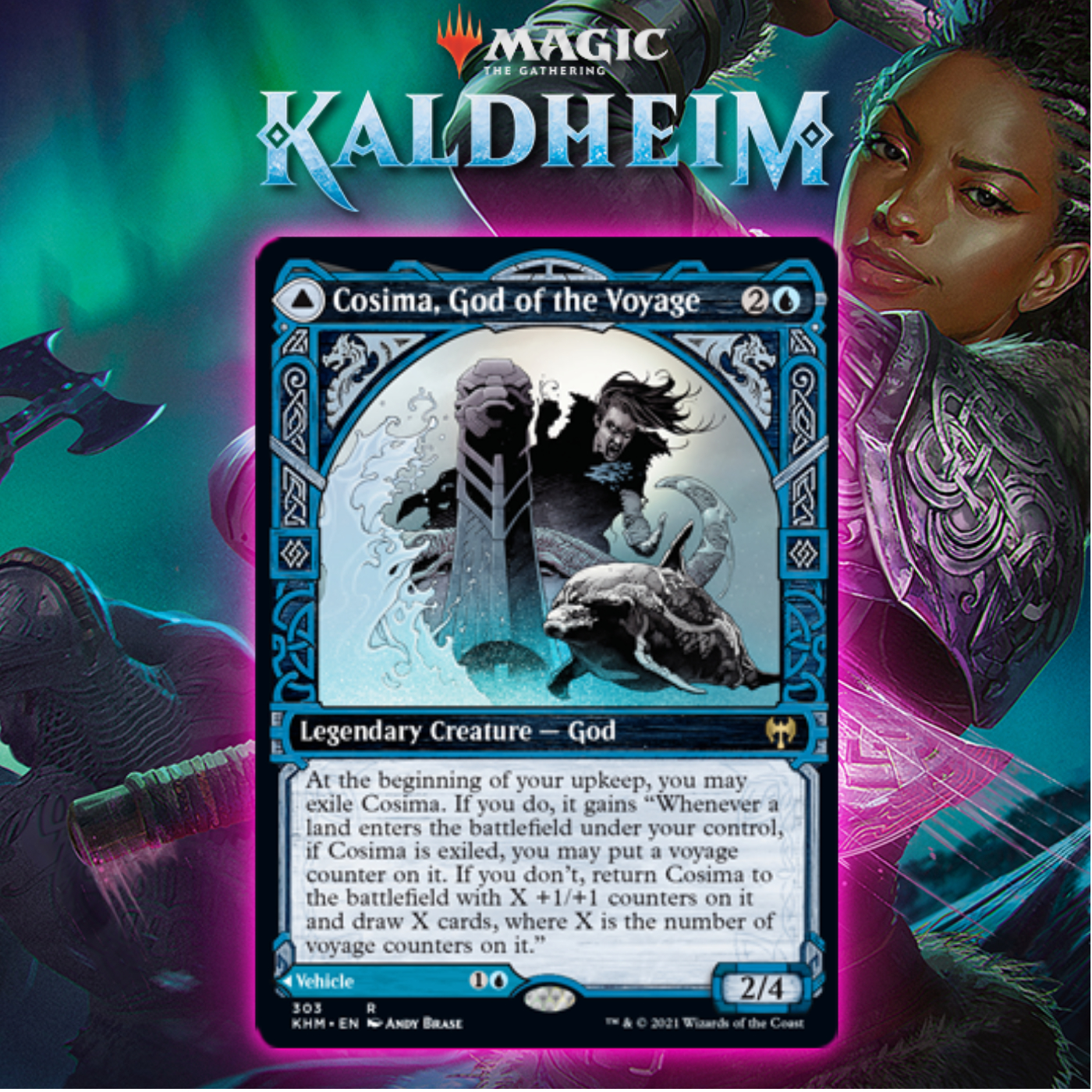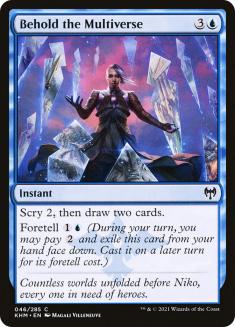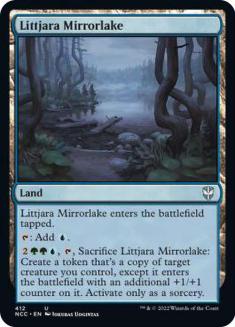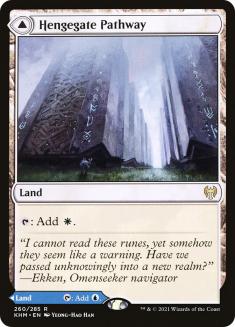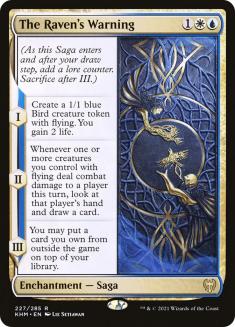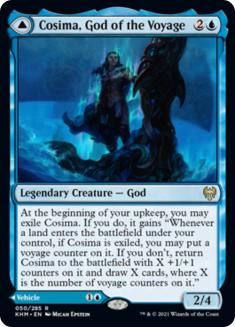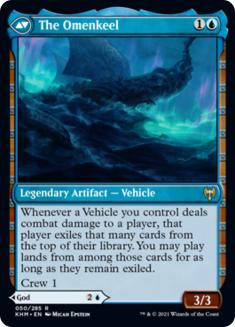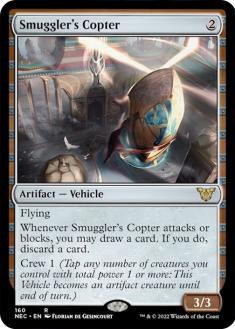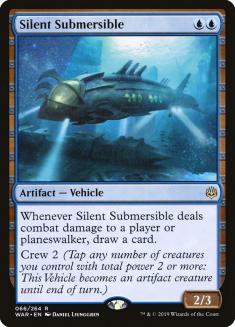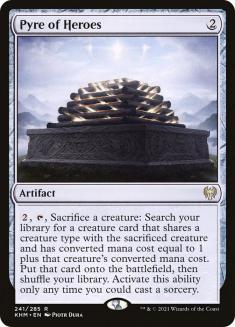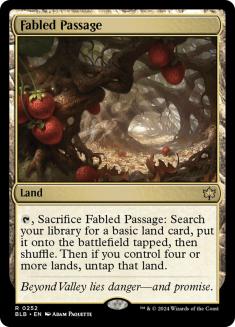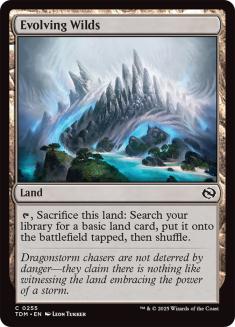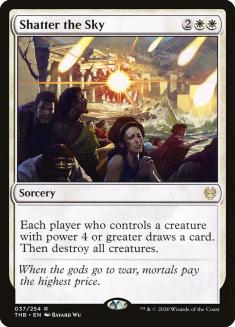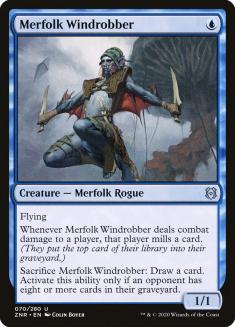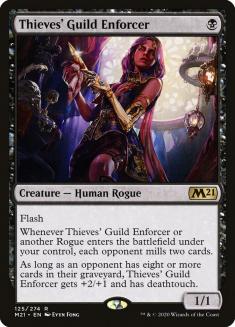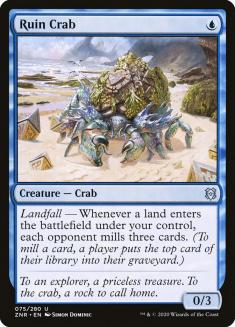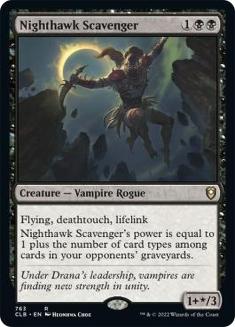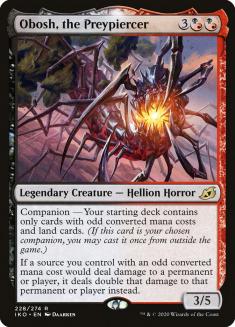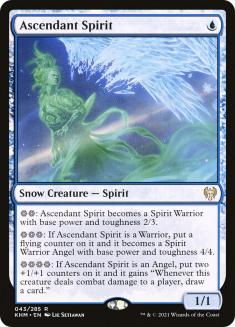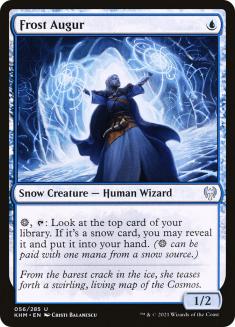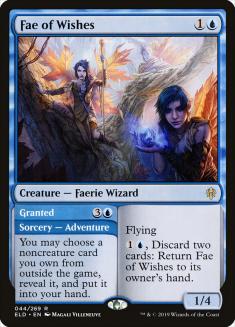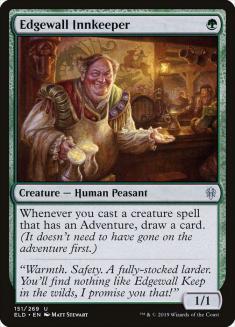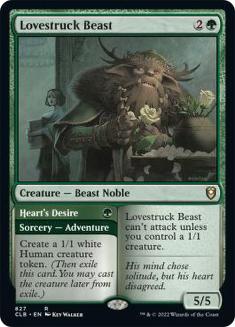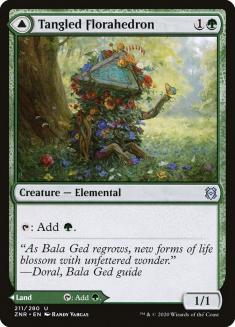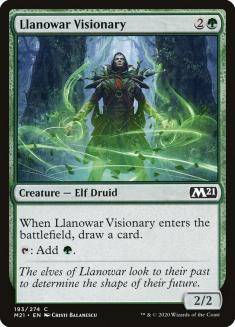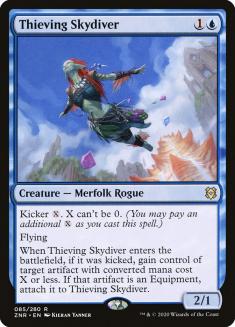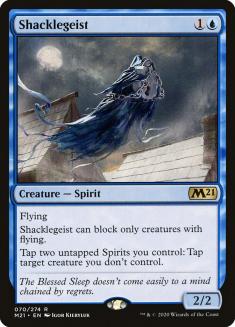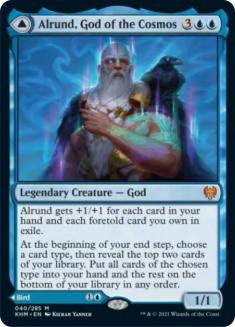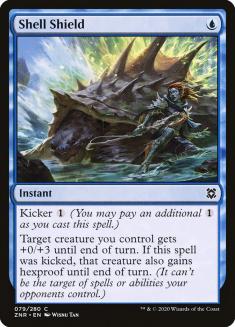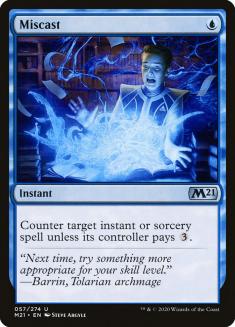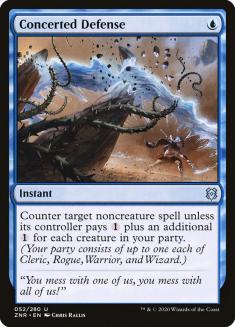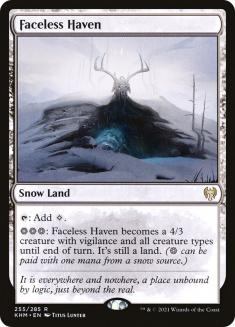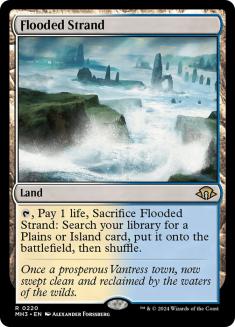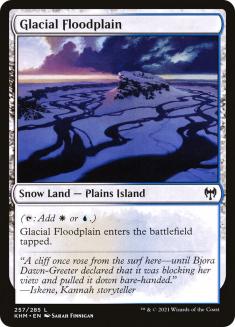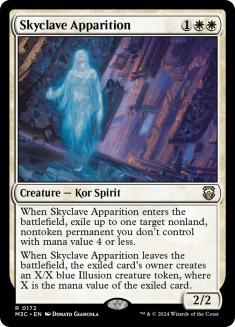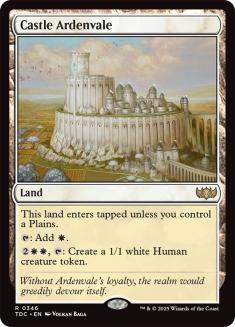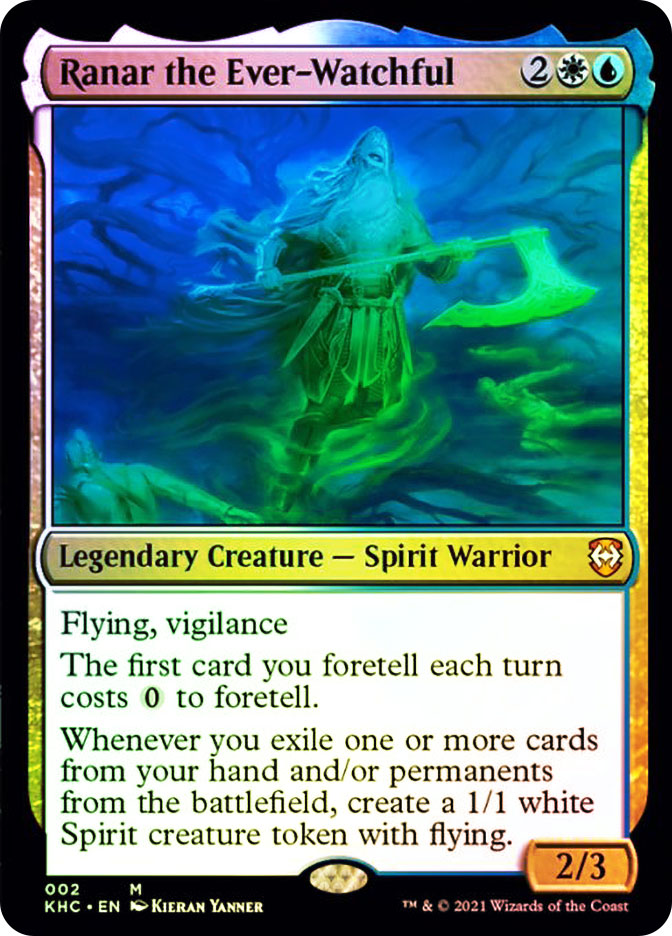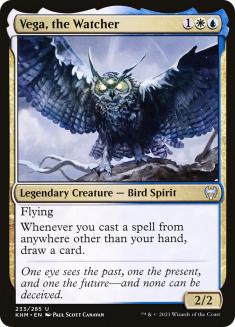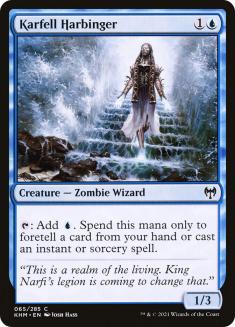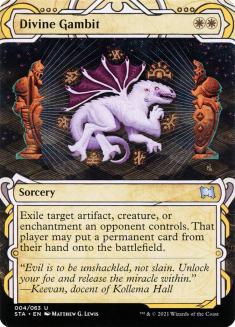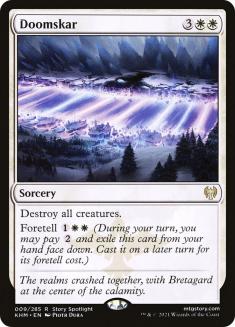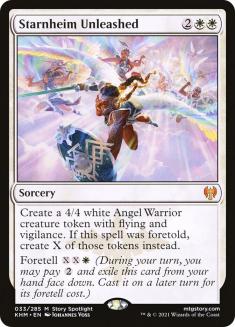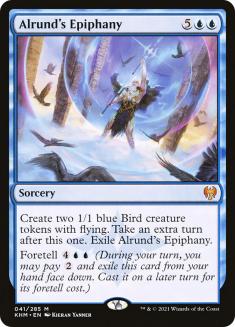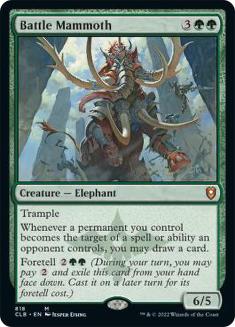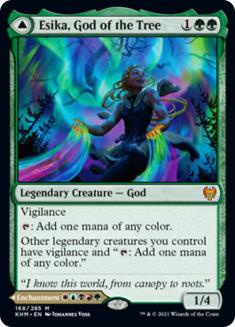I’ve been absolutely loving Kaldheim’s style of mechanical design (and the creative / flavor design of the set continues to crush it). One of the biggest design principles we’re seeing is a lot of meaningful choice between two different ways to play a card: foretell, lands with sacrifice abilities, and of course modal DFCs.
While Sagas are a little different, in having more than two chapters to them, they actually overlap quite a bit by having multiple possible ways of generating an advantage from a single card.
While a card like The Raven’s Warning doesn’t need every single chapter maximized to be useful, the potential is there if you’re willing to do the work (or naturally happen to have synergies that line up). To take full advantage of the card, you have to make good use of 1/1 flyers (even on Turn 3), value lifegain, care about card advantage, have other attackers with prospects of getting through on Turn 4, appreciate an enchantment generating advantage over a few turns (and then eventually going to the graveyard), and have a sideboard with ideal targets to put on top of your deck after chapter three.
That’s a lot of moving parts, a lot of variables, a lot of dimensions to the card making using it a lot less one-note. This style of design that has so many different axes on which you can improve the card with clever use of other cards is awesome when well-balanced, helping lead to formats where not every deck uses the same “good” cards.
Cosima, God of the Voyage is one such style of design, in the form of a modal DFC with two powerful options that kind of speak to fairly different styles of play (though with enough overlap to realistically build on).
Since The Omenkeel is the more constraining mode to utilize, I’d be inclined to start there for evaluating the card. The design certainly appears to be attempting to invite Smuggler’s Copter comparisons, though I don’t think they’re actually likely to play out very similarly.
While Smuggler’s Copter was a flying threat that helped ensure you didn’t run out of gas (potentially cashing in extra land) while also powering up graveyard synergies, The Omenkeel actually gives you more mana for using gas you get elsewhere. The lack of evasion is very pronounced and it’s not like blue was first, second, or third place for most common color of Smuggler’s Copter deck.
Setting aside the frequently banned Smuggler’s Copter, The Omenkeel is actually an attractive proposition in its own right. The closer comparison to start with is probably Silent Submersible.
Silent Submersible is harder to cast and takes twice the crew, while also being just a 2/3. The Omenkeel is a pretty sizeable upgrade in all three areas, so just how much worse of a trigger does it have?
Silent Submersible draws a card every time, while The Omenkeel “misses” some percentage of the time. That said, most decks have at least 33% land, even in this DFC world we live in, so you’re kind of netting more than one card on the average (and remember, you get to keep playing the lands as the game goes on, even if The Omenkeel is killed).
Of course, the real trick is that all you’re ever getting are lands. This makes getting a full card of value out of them somewhat of a challenge, since lands tend to have diminishing returns (particularly lands you’re drawing off your opponent’s deck). The said, we’re also getting to shrink the size of our opponent’s deck a bit with each hit.
This is probably not going to matter all the time, but it does let us disrupt attempts to set up the top of their deck (perhaps with cards like the aforementioned The Raven’s Warning), limit options for cards that let them search their deck (Pyre of Heroes), and possibly even speed up the clock for some kind of “run them out” backup plan, like you might see with Soaring Thought-Thief.
So, while The Omenkeel’s hit trigger takes a little more finesse (and doesn’t trigger from hitting planeswalkers), I’d guess an extra point of damage is enough to make up the difference. The Omenkeel doesn’t just have a third point of damage when it hits them, however. It’s also a 3/3 for combat with other creatures, which is a big deal.
Finally, Silent Submersible isn’t legendary, but again I’m giving the edge to The Omenkeel by a big margin, since the legendary drawback is even less than it’d normally be, on account of the card being playable as Cosima, God of the Voyage. The whole problem with legends is normally that the second copy has diminishing returns. However, in this case, the second copy of Cosima is actually much, much better than a second copy of Silent Submersible would be.
Okay, so The Omenkeel is basically better than Silent Submersible in like half a dozen ways. Big deal. So what?
The point is just that we’re talking about a lot more rate and a lot more flexibility. It’s a novel card, but one worth sitting up and taking notice about.
While maximizing The Omenkeel might take a lot, at a baseline, utilizing it requires two things:
- An efficient crew (one-power creatures making better crew members than fatties)
- Ways of utilizing all those lands over time
Additionally, depending on the format, we may also need ways to get The Omenkeel to connect with our opponent’s face.
What about Cosima herself?
One of the great parts of Cosima / The Omenkeel is that when The Omenkeel isn’t good, Cosima frequently will be. They’re also really great at helping each other, making drawing two a real boon (Cosima crewing The Omenkeel on-curve, and then The Omenkeel providing a steady supply of land to keep Cosima voyages in exile).
When played straight-up, Cosima starts off as a 2/4 for three, which isn’t above rate or anything, but it is a very efficient and practical distribution of stats. There is a shields-down moment for a turn, where she can be killed before setting off on her voyage; however, she also might provide some useful blocking during that time.
If she makes it to your next upkeep, the real fun begins. Now, every land you play gets you a counter that you’ll eventually be able to cash in for an extra card and a +1/+1 counter when you bring Cosima home (with the exception of whatever turn you cash it in, since you’re passing on another counter in order to collect on the counters you’ve accumulated).
Cosima coming back Turn 5 as a 3/5 that draws a card isn’t necessarily very exciting; however, it only gets better from there, and you don’t have to commit early on or anything. You can just keep stockpiling extra counters until you need to find an answer or even just run out of other things to do. The big thing is just making sure you’re able to keep hitting land drops, as it’s kind of a waste to have her out at sea if she isn’t even finding any land.
Even a single fetchland and we’re talking about doing pretty big things, since the counters aren’t limit one per turn or anything.
Both Cosima and The Omenkeel are interesting with sweepers like Shatter the Sky. While The Omenkeel is unaffected when uncrewed, Cosima can wait to return right after a Shatter the Sky thanks to your next land drop. Even if she’s already come back, she can disappear again just before we cast a sweeper. Things get even wilder if we’ve got The Omenkeel on the battlefield too for Cosima to immediately crew and get in there with.
Of course, trying to play sweepers in a deck with plenty of efficient crew members is already a pretty tall order itself. The overlap in the two designs is there, though. Both designs involve a strategy that’s okay with committing an early creature or two while still being set up to take advantage of continuing to hit land drops turn after turn.
In looking for the right home for Cosima, we might first start with looking at what blue decks might already have a crew ready to go.
Merfolk Windrobber and Thieves’ Guild Enforcer alongside Soaring Thought-Thief make a pretty good roster for crewing The Omenkeel (especially at instant speed and by surprise), and Rogues is a strategy that can make use of the extra mana, the extra cards over time, and even the exiling from deck. Is Rogues just the perfect deck for The Omenkeel?
Creatures (20)
- 4 Thieves' Guild Enforcer
- 4 Ruin Crab
- 4 Merfolk Windrobber
- 2 Nighthawk Scavenger
- 4 Soaring Thought-Thief
- 2 Cosima, God of the Voyage
Lands (23)
Spells (17)

There are two major points of contention that require us to re-evaluate some of our basic assumptions.
Ruin Crab can be a great enabler for Rogues decks. Playing with Cosima doesn’t mean we can’t play the Crab, but there is some inefficiency from having four of our one-drops unable to crew The Omenkeel. That said, Ruin Crab loves a steady stream of land, so at least it helps us make good use of all the lands we’re getting. Besides, if Ruin Crab is the only other creature we draw, we can also just cast Cosima for her God half.
Lurrus of the Dream-Den is the bigger sacrifice, since playing with Cosima in our list means we can’t use Lurrus as a companion. This isn’t just Cosima versus Lurrus or anything, though. Once we stop accommodating Lurrus, any number of other creatures with costs three and up become options.
On the note of companions with DFCs (and Cosima specifically), they count as just their front half in your decklist, which can mean some interesting things for cards that care about your starting deck, such as Obosh, the Preypiercer.
While Obosh requires you to not play cards that cost two, The Omenkeel counts as a three-drop in your deck. I’m not sure what this Obosh / Cosima deck looks like, but it is an interesting feature to keep in mind.
Another possible avenue to turn to for making use of Cosima is Ascendant Spirit, the new blue Figure of Destiny.
Setting aside the relative difference between Boros hybrid mana and snow mana, Ascendant Spirit’s first mode is definitely weaker, since two mana to become a 2/3 isn’t nearly as efficient as one to become a 2/2. It’s not terrible, however, and it only gets better from there (not to mention how often Figure of Destiny wasted a mana anyway, just from not having a one-mana play to use in the same turn).
The 4/4 having flying is already a better game piece by the second level (though it did cost an extra mana to get there). The third level is actually a big upgrade on Ascendant Spirit, though. Attacking with a 6/6 flying creature on Turn 4 is enormous (if you don’t get blown out by removal), and while the extra card may seem unimportant when you’re hitting them with a 6/6 flyer, it is more material and gives you another advantage to hold onto if your opponent can deal with your 6/6 next turn.
Unlike Figure of Destiny, Ascendant Spirit doesn’t stop at the third level, however. You can spend another four snow mana and go up to 8/8 flying, draw two cards per hit. “Coincidentally,” this curves perfectly so that if you play Ascendant Spirit against someone unable to defend themselves, it wins all by itself (assuming you have all snow lands) on Turn 5 — just level it up every turn.
Ascendant Spirit is a great crew member for The Omenkeel early on (no reason you have to start to level it up immediately), and the extra lands you get are certainly of value. Even if you’re not hitting anything snow, you’re still finding lands that can be used to cast the spells you draw while you use your snow lands to level up the Spirit.
On the other side, the kind of midrange gameplan Cosima aspires to is a great spot for Ascendant Spirit, even if the Spirit can be more aggressive and Cosima a little more “stall the game out.”
Creatures (31)
- 1 Gadwick, the Wizened
- 4 Fae of Wishes
- 4 Brazen Borrower
- 4 Merfolk Windrobber
- 2 Thieving Skydiver
- 4 Glasspool Mimic
- 4 Ascendant Spirit
- 4 Cosima, God of the Voyage
- 4 Frost Augur
Lands (19)
Spells (10)

Perhaps there is some kind of a new mono-blue creature deck that leverages Cosima and Frost Augur in lieu of any kind of Curiosity-type card.
Frost Augur draws 45% of a card in this deck, and realistically, we could get it even higher if we wanted. It’s also a great crew for The Omenkeel!
Fae of Wishes is a durable crew for The Omenkeel while also being a way to put extra lands to use. You can’t discard your opponent’s lands to it but you can discard your own and use your opponent’s lands to keep hitting your land drops.
I could also imagine Cosima finding a home in some kind of Adventure deck, while we’re on the topic. Green has some really efficient crews, plus there are plenty of cards you might want to play anyway that can do a passable job in a pinch.
As for mono-blue, we could kind of use more two-drops anyway, especially if we found one that worked really well for us.
Thieving Skydiver is kind of dubious, but a 2/1 flyer isn’t bad, and stealing opposing Equipment and Vehicles might actually be really sick in the format to come.
Shacklegeist’s ability is hard to use with the current mix of mono-blue options available to us and Alrund, God of the Cosmos just seems poor for attacking. I’m not a big fan of Alrund to start with, as the advantages it generates are just not the battles you want to be fighting, either on Turns 2-3 or on Turn 5. If you’re going to use him, however, he’s probably better suited to a plan involving more blocking and defense, rather than attacking and losing tempo from putting himself back into your hand (at least until the turn you’re ready to sweep the battlefield and then recast him as a big threat).
This strategy is very hungry for one-mana interaction but the current options are pretty meager. Shell Shield is no Dive Down and Miscast / Concerted Defense are no Spell Pierce. One or more of them might be a necessary evil, but they’re not ideal.
Amusingly, the Cosima + Ascendant Spirit tandem actually serves as a decent incentive not to play Snow-Covered basics for no reason. The Omenkeel’s hit-trigger steals your land, and since Ascendant Spirit’s ability powers up from having more snow land, any Snow-Covered basics they steal from you are actually a liability.
Of course, if you’re playing Cosima yourself, you probably want all Snow-Covered basics, regardless of whether you have any use for the snow mana, since you might steal other people’s Faceless Havens.
The Ascendant Spirit / Cosima package can be extended to a little higher-powered of formats, but cards like Curious Obsession aren’t a great fit with Cosima, nor even at their best on Ascendant Spirit.
Creatures (19)
- 4 Siren Stormtamer
- 4 Pteramander
- 3 Brazen Borrower
- 2 Merfolk Windrobber
- 4 Ascendant Spirit
- 2 Cosima, God of the Voyage
Lands (18)
Spells (23)

Once we’re going up in format, Ascendant Spirit can take on a really interesting new meaning in Modern on account of Spirit tribal, alongside true fetchlands enabling a snow manabase thanks to Glacial Floodplain.
Flooded Strand (and other fetchlands) being able to search up Glacial Floodplain makes it a lot easier to fuel snow-heavy abilities like Ascendant Spirit’s.
Creatures (35)
- 4 Drogskol Captain
- 4 Rattlechains
- 4 Spell Queller
- 2 Selfless Spirit
- 4 Mausoleum Wanderer
- 4 Supreme Phantom
- 1 Spectral Sailor
- 4 Shacklegeist
- 4 Skyclave Apparition
- 4 Ascendant Spirit
Lands (21)
Spells (4)

As for Standard, Cosima doesn’t have to be so focused on aggressive crews. You can play the card with a Plan A of casting her as a three-drop that aspires to play a sort of Courier of Kruphix role. This isn’t to say we’ll have no crew for The Omenkeel, however.
The Omenkeel crews come in all shapes and sizes, and you can still have plenty of ways to do it even while playing something a lot more controlling, such as:
Creatures (13)
Lands (22)
Spells (25)

While this is kind of a foretell-linear deck, it’s also an Azorius control deck that makes use of Cosima as a card draw engine.
Ranar the Ever-Watchful is kind of the foretell payoff, but it’s also just a strong card that works great with tons of cards. Sadly, exiling cards from The Omenkeel won’t trigger it, but the 1/1 flyer we get the turn we cast Ranar (from foretelling something for zero) makes a great crew, even if Ranar meets an untimely demise.
Not nearly as exciting as Ranar, but worth at least a shot. It’s probably just too vulnerable and unreliable for how many other amazing three-cost options we could play, but it might be worth it.
Karfell Harbinger could be a decent crew member and works with foretell; however, a 1/3 that doesn’t draw a card or anything is just not on message for what the control parts of this deck are trying to do.
Not being able to hit planeswalkers is enough to have me off Divine Gambit, at least in this list. The card will have plenty of spots, though.
While a five-cost sweeper isn’t turning any heads these days, it’s not bad. Once you factor in the foretell ability, we’re talking about a quality card. It’s not even about synergies. It’s just the fact that we can put our mana to good use, stockpiling future tempo so that we can sweep the battlefield and still leave up countermagic (or make a second strong play in the same turn). There’s also a lot of appeal to Doomskar as a catch-up mechanism, letting us invest in and cast a sweeper even if we’re a bit short on mana.
I’m not sure how many expensive cards we can really afford to play, but Starnheim Unleashed can get pretty sweet and give us a plan for going big. It’s not the least Broodmate Dragon card I’ve ever seen.
As for Alrund’s Epiphany, it’s not as good here as it would be in a green deck, but it might play. We’ve got a lot of creatures and can really set up some spots where an extra turn would be disproportionately valuable. A green deck might be a better spot for it, though, both from harder-hitting creatures for an extra attack and from acceleration to cast this card earlier than Turn 6.
Cosima, God of the Voyage is the card I’m most looking forward to playing from Kaldheim, so far, both for how fun it is and for how strong.

